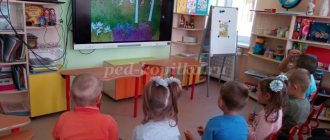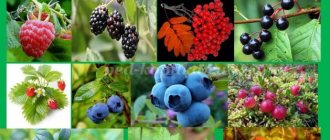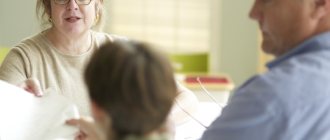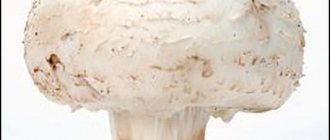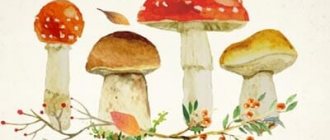Games
Different pictures of mushrooms for children allow you to conduct many different kinds of speech therapy games. Here are some examples:
- Collecting mushrooms
Each player chooses one picture of a mushroom and tries to describe its external features. If the other player guesses right, the card goes to him. The one who collects the most pictures wins.
- How are we similar?
An adult chooses two cards (boletus-boletus, white-boletus, russula-fly agaric) and invites the children to see as many differences between them as possible. The last one to answer wins.
- Cheerful cooks
Invite the children to “cook” a lunch of different edible mushrooms that they know. Everyone must choose one picture and name a dish that can be prepared with one or another mushroom (for example: porcini mushroom soup, pickled boletus, boletus mushrooms in sour cream, salted milk mushrooms, etc.
- Oh, what a honey fungus we have!
The image of any mushroom is transmitted from one player to another. Everyone names one of its characteristics, distinctive features of the external structure. The winner is the participant who can see and name some detail last.
- Tales from storytellers
Ask each player to choose one specially selected picture of a mushroom for children. Then everyone must come up with a short story about their character. Tell about his character, habits, activities. For example, Borovik is the king of all mushrooms in the forest, he is strict and important, busy with government affairs from morning to evening, loves to play football and play the balalaika. Older preschoolers can be asked to come up (in a circle) with a whole story about the mushroom kingdom; everyone can draw illustrations for the fairy tale together.
- Mosaic: find a piece
Make cut-out pictures from the cards and invite your child to assemble them. You can use drawings of poisonous and edible mushrooms for this game.
- Full basket
Invite your child to select several cards (he will need a small basket for this), memorize them well and repeat all the names by heart without looking into the basket again. Each player can try to become a mushroom picker by collecting their own set of cards.
Summary of GCD in the senior group on the topic Mushrooms
Abstract of the educational activity in the senior group on the topic “Visiting the Hedgehog (Mushrooms)”
Author: Kondratyeva Natalia Aleksandrovna, teacher of the MDOU - kindergarten No. 196 of the compensatory type in Saratov. Description of the material: I bring to your attention a summary of direct educational activities on cognitive development (Familiarization with the surrounding world. Natural world) for children of the older group (5 - 6 years old) on the topic “Visiting the Hedgehog (Mushrooms).”
Taking into account the specifics of my correctional ophthalmology group, I used techniques and methods aimed at developing intact analyzers (hearing, fine motor skills, tactile sensations), and also applied the necessary health-saving technologies (eye gymnastics, working with an ophthalmic simulator, physical education, finger play). ECD is aimed at developing the cognitive interest of older preschoolers, consolidating ideas about mushrooms, correcting vision, and nurturing an environmental culture. Abstract of the GCD in the senior group on the topic “Visiting the Hedgehog (Mushrooms)”
Purpose: to create conditions for the development and consolidation of children’s ideas about mushrooms, features of appearance, places of growth. Objectives: Educational: - give an idea of the mycelium; teach to distinguish between edible and poisonous mushrooms; expand and activate vocabulary on the topic. Correctional and developmental: - develop cognitive interest; — develop attention when solving game tasks; - develop visual and auditory perception, attention, memory; - develop coordination of words and movements; - develop fine and gross motor skills; - enrich visual impressions; — strengthen the ability to work with noisy pictures. Educational: - foster respect for the environment. Types of activities: gaming, motor, communicative, perception of fiction, visual arts. Forms of implementation of children's activities: games with speech accompaniment, guessing riddles, listening to the sounds of nature, answering questions during a conversation, tracing noisy pictures. Equipment and facilities: toys – crow, hedgehog; cookies - “mushrooms”, basket, pictures with mushrooms, picture-diagram of a mushroom, dummies of mushrooms, autumn leaves made of colored cardboard with riddles, audio recording “The Sound of Rain”, tape recorder, sheets with noisy pictures, black felt-tip pens (according to the number of children), Miracle -tree (model of a tree), ophthalmic simulators with images of mushrooms on the walls of the group. Vocabulary work: mycelium, spores, mushroom pickers. Methodological techniques: creating a game situation, conversation, eye gymnastics, guessing riddles, finger play, didactic game, surprise moment. Preliminary work: reading poetry, guessing riddles about mushrooms, talking about the gifts of the forest, about the signs of autumn, looking at illustrations, playing with noisy pictures. GCD progress: I. Org. moment: (Children are sitting on chairs in front of a magnetic board.
)
Educator: Guys, a guest arrived in our group today. Did you recognize her? Children: Yes, this is Smart Crow. Smart Crow: Kar-kar! Hello guys. Yes, I came to see you again. Hedgehog sent me from the forest. He gave you this letter on a piece of paper. Did you find out what tree this leaf fell from? Children: Yes, from a maple tree. This is a maple leaf. Smart Crow: Well done, right. The hedgehog collected a lot of supplies for the winter and wanted to share with you. But the Hedgehog lives far in the forest and the path to his hole is long and difficult. That's why he asked me to help you, to show you the way. Educator: Crow, what is written on the piece of paper, let me read it to the guys. The hedgehog asked us a riddle. When we guess it, we will find out what the hedgehog likes to collect most in the forest? (Riddle on a maple leaf):
Who sits on a strong leg In the brown leaves by the path A grass hat has stood up - Is there no head under the hat?
(mushroom) Children: This is a mushroom. Educator: That's right, well done! Crow, do you know everything about mushrooms? No? Well, then listen, and you guys listen and watch carefully. II. Main part. 1. Topic message: Educator: Mushrooms are unusual plants; they have no branches, no leaves, no flowers. (A picture is hung on the board - a diagram of a mushroom).
What do mushrooms have?
(Children answer that there is a leg and a cap.)
That’s right, a leg, a cap, roots - a mycelium.
Fungi reproduce by spores. Spores are small particles that hide in the caps of mushrooms. When the mushrooms ripen, the spores fall to the ground. Small mushrooms grow from the spores. Through the roots-threads, mushrooms receive water and nutrients from the ground. People who go into the forest to pick mushrooms are called mushroom pickers. Real mushroom pickers take care of the forest and never pull mushrooms out of the ground by the roots, as this can damage the mycelium, and then small mushrooms will not grow in this place. The mushroom must be carefully cut with a knife. 2. Conversation: “The mushroom and its house.” (The teacher, talking about a mushroom, puts up a picture with its image.) Educator: Each mushroom has its own home where it grows. The boletus mushroom grows in pine and spruce forests. His hat is fleshy, elastic, light gray or brown. The leg is thick and white. Porcini mushrooms are dried and then made into soup. Butterflies grow in the pine forest. Why do you think these mushrooms are called that? (Children's answers.)
Yes, their hat is slippery, as if it was greased with oil.
What mushroom did we find under the aspen tree? Children: We found a boletus under an aspen tree. Educator: That's right, and under the birch tree? Children: We found a boletus under a birch tree. Educator: Well done! The boletus and boletus have a long stem and a brown or reddish cap (like fallen autumn leaves in which mushrooms are hidden). But in the thick grass, chanterelles grew - red, like a forest animal - a fox. Hey, what kind of miracle stump is this? All covered with mushrooms. These are honey mushrooms - friendly guys, they grow up in large families on tree stumps. We talked about edible mushrooms. They can be boiled, fried, pickled, dried. But in the clearing we saw a beautiful mushroom: a thin white leg with a skirt, a red cap with white spots. Can you guess what kind of mushroom this is? Children: This is a fly agaric! Educator: Yes. When the fly agaric gets old, the edges of its cap bend upward and it turns into a saucer. If it rains, there will be water left in the saucer. Not simple - poisonous. A fly drinks this water and dies. That's why they call it Fly Agaric. What other poisonous mushroom do you guys know? (Children's answers.)
That's right, pale grebe.
This mushroom has a long thin stem and a pale gray cap. She has an unpleasant smell. Now you know which mushrooms are edible and which are poisonous. Let's go visit Hedgehog. We’ll take a basket with you (as mushroom pickers do - people who pick mushrooms) and along the way we’ll collect a gift for him - edible mushrooms that we come across. Show us the way to the Hedgehog's hole, Clever Crow. (The teacher picks up the Crow and the basket.) 3. Dynamic pause: physical education and gymnastics for the eyes “Rain.” Educator: Get up, guys, come to me, hold hands and in a chain we will go along the winding path into the forest behind Smart Crow. Remind me how to behave in the forest? Children: (Suggested answers: you can’t make noise in the forest, break tree branches, watch your step carefully so as not to step on a mushroom or damage the anthill.) (The children follow the teacher in a snake from the board to the carpet. The audio recording “The Sound of Rain” is turned on). Educator: Oh, guys, do you hear? What is that sound? Children's answers. Educator: You are right, you can hear the sound of water, it’s starting to rain! Let's see how it rains. (Children stand in a circle in the center of the carpet.) Gymnastics “Rain” The first drop fell - drop! And the second one ran! (They show the trajectory of the drops with a finger from above and follow them with their eyes.)
We looked at the sky:
(They look up.)
The droplets began to sing “drip-drip.”
Our faces got wet, we wiped them. (They wipe their face with their hands.)
Look, the shoes have become wet.
(They point with their hands down and look at their feet.)
We will move our shoulders together, shake off the droplets.
(They move their shoulders from side to side, hands on their belts.)
We will run away from the rain,
(They run after each other in a circle.)
We will sit under a bush.
(They squat.) (The sound of the rain stops.) Educator: The rain has stopped. There are so many leaves lying around on the ground in the forest! And not just leaves. After rain, mushrooms grow faster in the forest. 4. Didactic game “Find a mushroom - guess the riddle.” Smart Crow: Whoever finds a mushroom, take a leaf, there is a riddle on it. (The children find and present to the teacher and Smart Crow a dummy mushroom and a piece of colored cardboard with a riddle.) Educator: Well, guess what kind of mushroom it is. Riddle 1. On a thick white stem Brown cap Surely every mushroom picker dreams of finding... (boletus). Educator: Guys, let's take this mushroom? Edible boletus mushroom? Look at it carefully, touch it. (Children answer, look at the dummy mushroom, examine it by touch, put it in a basket. Same with the rest of the mushrooms.) Riddle 2. Hidden unnoticed Under a birch tree in the cold, Brown mushroom On a spotted root. (Boletus mushroom) (Children find a fly agaric and immediately recognize it. If they don’t recognize it, the teacher reads the riddle.) Riddle 3. The leg is white, straight, The hat is so red, And on the hat, on the top, there are white hemp. (Fly agaric) Educator: Guys, why didn’t you put the fly agaric in the basket? Children's answers. Smart Crow: That's right, you don't need to put the fly agaric in the basket, but you shouldn't trample on it either. Leave it and let it grow. Many mushrooms that are poisonous to humans are beneficial to forest inhabitants. For example, a moose I know is treated with fly agarics. Let's leave him this handsome guy in the red hat. (The children find another mushroom. There is no leaf with a riddle next to it.) Educator: What kind of mushroom is this, who knows? (Children give conflicting answers or remain silent.)
Crow, do you doubt it too?
Remember an important rule that must be followed when picking mushrooms: “If you don’t know what kind of mushroom it is, you’re not sure whether it’s edible or not, then don’t pick it, let it grow.” We'll leave it to the animals. Educator: Oh, Crow, it’s a long road to Hedgehog’s hole, we’re a little tired. Let's sit down on the stumps and rest. (Children sit on chairs near tables connected by two. On the tables in front of each child is an A4 sheet with a noisy picture and markers.)
And here we also have mushrooms hidden in the pictures.
Before looking for mushrooms, let's show Smart Crow how we can play with our fingers. 5. Finger game “For mushrooms”. Top top. Five steps, (Children use the index and middle fingers of both hands to “walk” along the table.) There are
five mushrooms in the little bowl.
(Show spread fingers.)
Red fly agaric -
(For each name of the mushroom, bend the fingers on both hands in turn, starting with the thumbs.)
The mushroom is dangerous.
And the second is a fox, Red-haired sister. The third mushroom is the pink ear volushka. And the fourth mushroom is the morel. The fifth mushroom is white, eat it boldly. 6. Didactic game “Find and circle the mushroom.” Children find the outline of a mushroom in the noisy pictures and trace it with a black felt-tip pen. The teacher helps individually and evaluates after finishing the work. 7. Ophthalmic simulator (to relieve visual strain). Educator: Guys, look for a squirrel with a basket of mushrooms. (Children find a picture on the group wall.)
See how many mushrooms she picked!
And we have quite a few in our basket too, look. (The children look at the basket with dummies of mushrooms, which stands in front of them on the table.)
Now get up, let’s go further to look for the Hedgehog.
Smart Crow: Yes, we are almost there. You see a spreading tree with a Hedgehog hole under it. (Children with a teacher approach the Miracle Tree with maple leaves in the Nature Corner.) (A toy Hedgehog appears from behind the tree.) Hedgehog: Hello, guys, I’m so glad you came! I watched you as you walked through the forest. You are so great! Treat the forest and its inhabitants with care: not a single branch was broken, not a single mushroom or berry was trampled, and no noise was made. 8. Didactic game “What do we take in the basket?” The hedgehog names the mushrooms that were mentioned during the GCD. If it is edible, the children clap (put it in the basket), if it is poisonous, they do not clap. The hedgehog praises. Educator: Hedgehog, on the way to you we picked a basket full of edible mushrooms. Help yourself and treat Smart Crow. 9. Surprise moment. Hedgehog: Well done, guys! I really liked you. Thanks for the mushrooms. And I will share my supplies with you. (A basket of mushrooms—cookies—appears from behind a tree.)
Help yourself, but remember, these mushrooms are not simple, but magical.
As soon as you eat them, you will be back in your group. Goodbye. Come again! (Children thank you for the treat, say goodbye to the Hedgehog and Smart Crow, eat 1 mushroom each.) III. Bottom line. Educator: Well, guys, we are back in our group. You are all great fellows, you completed all the tasks! Did you enjoy the trip? What will you tell your parents about him, what did you learn about, what did you do? Children's answers. Conclusion. A change of entertaining tasks, character toys, bright visual material, dummies, group design, noise accompaniment and surprise treats helped make the educational activity interesting and memorable for children. This development can be used by teachers of both correctional groups and general development groups.
We recommend watching:
Summary of a winter walk in the senior group Summary of educational activities for the formation of a healthy lifestyle in the senior group Summary of a lesson on speech development with children of the senior group Summary of a lesson in the senior group
Similar articles:
How to use forest gifts. Rules for picking mushrooms for children
Description of mushrooms
Quiz on the theme Autumn
Puzzles
It is very useful to teach riddles on a chosen topic with children. This helps not only to train the preschooler’s memory and attention, but also significantly increases his vocabulary, and also allows him to automate difficult sounds. Here is a selection of suitable riddles called Basket of Mushrooms for Kids:
Recommendations for conducting classes
If you want to use pictures of mushrooms for activities with children, then you should consider several rules for their use:
- Give your child the opportunity to take a good look and study new images in each drawing, and only then use them for educational exercises or games.
- Pay attention to the quality of the pictures. It is best to use special speech therapy illustration sets produced for kindergarten, but you can also take realistic images from the Internet or use photographs.
- Be sure to select a variety of handouts - both subject pictures and plot ones. The first are small cards with single images of mushrooms, and the second are illustrations of a real (hedgehog with mushrooms) or fairy-tale (series of pictures Under a mushroom) situation on the topic. For the development of speech in preschoolers, both types of visual material are necessary.
- Any illustration for classes must be made in a realistic manner, accurately repeating all the elements of the external structure of a particular object.
- It is most convenient to use cards with names that older preschoolers can read themselves.
- Images of mushrooms on a transparent background significantly expand the possibilities of using them when composing stories.
Cards by Glen Doman on the topic “Mushrooms”:
